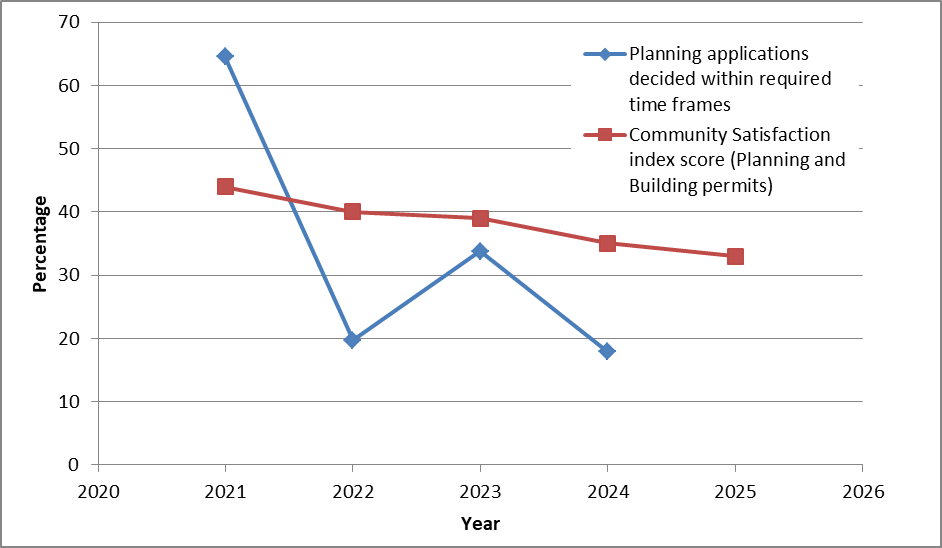The 2023/24 Local Government Performance Reporting Framework (LGPRF) rankings have delivered a sobering verdict: Hepburn Shire takes longer than any other council in Victoria to decide planning applications. As posted by Council Watch, and re-posted in local social media, the Shire sits at the top of the list in terms of average time taken for planning approvals at 180 days.
The Shire’s own Annual Performance Statement for 2024/25 highlights a steady decline in the percentage of planning applications decided within the statutory 60-day timeframe over the past five years. According to the Council’s Annual performance Statement for the year ending June 2024, the proprotion of planning applications decided within the required timelines was 64.5% 2021 but has declined to 17.9% in 2024.
Community satisfaction survey results reflect growing dissatisfaction with increasingly protracted planning timeframes with scores dropping year-on-year since 2019. In 2021 the Community Satisfaction index score for Planning and Building permits was 44. In the most recent survey, the community satisfaction score has decreased to 33, equal lowest with Sealed local roads.
In response, Ron Torres, Director of Development and Community, emphasized the complexity and resource-intensiveness of the Shire’s planning responsibilities.
“Hepburn Shire Council strives to provide the best possible service to applicants within its available, and limited resources,” he said. “Many planning applications do take substantial applicant and Council time to complete. The Shire is blessed with significant natural resources, heritage and natural risks that often need to be carefully considered … and nearly always require input from state agencies and utility authorities.”
Torres went on to critique VicSmart’s uniform timeframes for simple permits. VicSmart is a streamlined, fast-track planning permit process introduced in September 2014 across Victoria’s planning schemes. It applies to certain low-impact and straightforward applications—like tree removal, front fences, minor building works, or simple subdivisions—and mandates a decision within 10 business days, provided the application is complete.
“For very simple VicSmart applications, Victoria has a one-size-fits-all ‘time to complete’ system that does not recognise different levels of assessment complexity,” said Mr Torres.
He reiterated the council’s commitment to balancing thorough assessments with timeliness, acknowledging there’s “a way to go yet” but affirming the team’s dedication to continuous improvement.
Victorian law mandates a 60-day decision window for most planning applications, but this clock is routinely halted by requirements such as additional information requests, advertising, external referrals, or committee escalations—which, in practice, can stretch the process well beyond six months.
The Shire’s rich heritage, environmental sensitivities (including the mineral springs and bushfire risk zones), and require referrals to external agencies and increase the time requirements and the workload for planning department employees. As a small rural council, Hepburn has fewer staff and budgetary flexibility than urban counterparts, making it challenging to keep pace with growing demand and complexity.
The performance data is clear: Hepburn Shire is benchmarking poorly in planning application turnaround. Legitimate complexities and resource constraints play a role. Council’s acknowledgment of the issue, paired with systemic process improvements, will be essential to rebuilding community confidence and ensuring future development doesn’t stall.





